Are you looking for fun and engaging writing projects for your students at the end of the school year? Look no further! In this episode, I share five writing projects that will keep your students motivated and excited about writing until the last day of school. You can recreate these projects yourself using Google Docs and Slides or purchase them below. You can also find the transcript for this episode below.
$8.00
This is an awesome writing project to get your class lovin’ writing! This project gives students the opportunity to reflect on their personality and life, write in any format (paragraph, list, poem, table, song) about 26 school topics for each letter of the alphabet. This project gives students the opportunity to be creative in the topics they choose and the kind of pictures and art they include in their encyclopedia. If technology is available, students will love being able to use Microsoft Word or Google Docs to create their encyclopedias. I’ve done this project for three years and students always become incredibly engaged after I assign it, which is exactly what we want during our writing instruction!

Transcript of Episode:
I would love to tell you about five of my favorite mini projects to do at the end of the year that are extremely engaging for students and really will benefit students for years and years and years to come.
Are you ready? Let’s get started. This episode is gonna be just a little bit different because I am publishing more episodes that are just more conversational rather than, than formal blog posts. You can find all of the resources for this episode on amandawritenow.com if you click podcast and look for the title of the episode. And you can also find all of these projects on my website as well by clicking shop or courses. So everything I talk about today, you could implement on your own and it would be fairly easy. I mean, you, it might take you a few hours to plan it and get all the materials together, or you could go on Amanda right now.com and purchase these little mini projects, mini units.
And they’re all related to helping students develop their writing skills, but also really get them excited to write at the end of the year. And that’s really hard because the end of the year is a time when everyone is just dying for summer and a break. And that’s why I’m recording this episode because I really want to help you out so that the end of the year is a fun time, an exciting time, an energetic time, a time for students, and for you to have fun. So the first project that I would like to tell you about is actually my newest, uh, product on my website, Amanda, right now.com. If you kick click shop, and I’m gonna tell you about it, and as I’m telling you about it, feel free to take notes and replicate this in your own way. This project is called the Free Choice Writing Project.
This project is basically just a bunch of Google Slides, 18 different slides, and each slide has a different genre of writing. For example, if students were really interested in learning about writing on a blog or students were really interested in writing a scary story or a picture book, or a comic strip, or a comedy sketch where they’re actually, it’s like a standup comedy sketch. So they’re planning out what they would say to an audience or a TED Talk. Uh, all of these genres have their own dedicated slide and you could very easily replicate this, um, on your own. Or you could go to Amanda right now.com and go ahead and just purchase it. It’s $10, which is really, really cheap for an editable Google slideshow with the amount of information that is in this slideshow and just what you can do with it with students.
So, students will pick the genre that they’re most interested in writing. And so I have, there’s a, a table, uh, I think the first slide of the slideshow is a table. And so there’s informative and or argumentative writing on one column and then creative writing in another column. And so there’s a bunch of genres for argumentative and informative. And then there’s a bunch of genres for creative writing. And I allow students to work by themselves or in, uh, partnership. So just two other students. Cuz if you start getting into big groups, uh, it’s hard to manage the workload that each student is taking on, but if students are working in pairs, they’re more easily able to like divide up the work. So, uh, so basically you, you introduced the project to students and you say, Hey, I really want you all to experience learning about a genre that you’re interested in.
Each slide explains what the genre is, the materials that you will need to write within that genre. So for example, if students want to write a blog or start a blog, the materials they might need, and these are all optional, are, uh, blogger WordPress, wick weebly or card.co. And then there’s links to all of these as well on this slide. And then also on the each slide are examples of this type of writing. So, and this is all linked, so there’s clickable link. Students can, can investigate and learn more about it. And there’s a video overview of the structure of this genre. So students can click and watch a video about this genre of writing as well. And then there’s requirements. So, uh, there’s a list of what students need to do for this project. Uh, there’s a rubric that’s designed specifically for that genre of writing.
So there’s a rubric for every genre of writing. There’s a rubric for the blog post, there’s a rubric if students want to create a poster, a brochure, a scary story, a fantasy story. If students want to write poetry, there’s a rubric for every single genre and it’s linked in each slide. And, uh, the rubrics are editable, which is really, really awesome. My students loved this project. They really, really enjoyed it and it was so fun to watch them get excited about, uh, writing and, and being content creators. And it is very real world, uh, a lot of the genres. So I definitely recommend you check out this fun project. I think your students will love it. The next project that I want to talk about is the Encyclopedia Memoir project. This project is probably the oldest product I have on in my store, uh, but it’s also, uh, one of the most popular and lots of teachers purchase this product at the end of the year because it’s a really great way to, for students to reflect on their school year.
And it doesn’t necessarily, the, the memoir project doesn’t have to be about the school year. It could just be about the student’s lives. And you get to kind of decide how students use this project. This is also found on my website, Amanda, right now.com. Click shop and go, uh, find the Encyclopedia Memoir Writing project. So what exactly is this? So this project gives students the opportunity to reflect on their personality and life or even the school year if you wanted them to stick to just the school year because it can become like kind of a, a little bit of a time capsule or a yearbook for them, which is really neat. So students will, uh, for every letter of the alphabet, they will write in any format they want about, uh, if, if they’re doing it about the school year, then it should be about 26 every, uh, letter of the alphabet.
There’s 26 letters, 26 school topics. But if it’s about just their life, then it can be 26 topics about them and their lives and who they are. And they can pick any format for each letter. So for example, the letter A, it could be a list, it could be a poem, it could be a table, it could be a song, a story, a paragraph, uh, it could be anything really, any format. This project gives students the opportunity to be creative in the topics they choose for each letter, the kinds of pictures and art they include in their encyclopedia. And you can use Google Docs if you want Google Slides, if you want. You could have students choose to do slides or they could do hand uh, handwritten, hand drawn type of encyclopedia. And this product includes my, uh, encyclopedia that I actually created during my student teaching, like 16, 17 years ago. And
All of my entries in my inci my own encyclopedia. And so there’s lots and lots of examples of, of what this encyclopedia might look like when they’re finished. And it is just super, super engaging and students love it because they get to kind of come up with different topics for each letter of the alphabet and it’s all about them and it’s all about their interests. And it’s really fun to share as a class at the end and kind of be able to, to get to know each other even at the end of the year. And this is also a really fun project for the beginning of the year as well. Uh, and so that is the second project that I want to tell you about. The next ones are, uh, actually all included in, uh, sort of a course on teaching. Um, three, the next three topics.
And these can be kind of little mini units that you do at the end of the year. And I really think that all of these topics are super, super valuable for students to learn about and they’re super engaging. So the first one is learning all about journaling and the power of journaling. Now, of all the projects I’m talking about today, this one is more of a full unit, but it doesn’t have to be. You could take this unit and um, and just teach some of the lessons in it. And actually, I’m looking at my shop right now and I think it’s available when you click shop. If it’s not, I will definitely put it, uh, in my shop. Yes, it is available. So it’s called the Journal Writing Unit and this one’s $15. Uh, and so basically you’re gonna get an editable unit at a glance and, uh, I think there’s 10 many lessons and a lot of different editable tools that you can use to teach students about why developing a daily journaling writing habit is really good idea.
The types of journals that students can keep describing just the benefits of journaling. Uh, helping students make lists to generate ideas to write about in their journal and different ways they can use their journal, like emulating authors to practice writing, creating like timelines of important events in their life, drawing pictures in their journal cuz some types of journals, they’re just blank pages. And so it’s more of like a sketchbook, uh, teaching students about just how to use a journal to just get their thoughts out, uh, and, um, how to use their journal to maybe just like ask questions and research different topics they’re interested in or just keep ideas for stories how to, how they could use their journal to collect words, um, that they, if they’re really into kind of learning big words, uh, using their journal to just organize information that’s important to them or write about books that they really love and that they, they wanna read or books that they have read.
Just keeping track of that kind of thing. And I, I love this unit because I have a lot of old journals from my past, and so I can pull those out and kind of show students some of the things that I wrote, uh, as a kid. And if you have something like that, that’s a really good idea. But I just think that teaching students the power of journaling is something that’s really missing in English curriculums. And so at the end of the year it can be really great time to, to make time for that. Uh, and so that’s the third idea I have for you. The fourth project idea that I have for you is teaching students about sketch noting. And of all the uni all of these projects, these little mini units, I feel like sketch noting, um, is something that they can use over and over again in future classes.
The sketchnoting is not necessarily a unit, it’s actually within a course that I offer called journaling, sketch notes and mindfulness. That’s the fifth topic that I’m gonna talk about teaching students about mindfulness and meditation. So you could get that entire course and access all the materials to teach these topics, including the journaling, or you could just go and buy the journaling unit all by itself in the shop. But if you click courses, you’ll find journaling, sketch notes and mindfulness. And that is a course, but it’s not really a course. It’s more just like step by step how to teach these topics and the materials you need to teach them. For the sketch notes topic, you’re going to get a editable sketchnoting Google Doc and it lists all the different activities that you can do to help students learn how to sketch note. So for example, the first lesson is teaching students just types of note taking and there’s like links to videos and things like that in that lesson. And, and then also practice with students choosing the, their, the type of note taking they like best. Not just sketch notes, but uh, Cornell notes the outline method, um, and mind mapping I think are the different types of note taking that are taught and, and annotation.
And then after that, there are videos of the eight steps you need to take to start sketchnoting. A lot of students are really intimidated by sketch notes and think that they have to be some like artists to do it. That’s not true at all. And so, uh, and that that this lesson kind of talks about that, uh, and gives students really, really basic, uh, directions for drawing and just shows students how simple it really can be. Uh, when you’re sketching and actually when you’re taking sketch notes, they’re usually pretty messy. And so you want to review the notes, you go back and you kind of redo them and reorganize them. And that’s all taught in here. There’s also types of sketch notes that are taught and there’s videos to go with it and teaching if you’re, if you feel like you’re not an artist and you can’t teach this, I have a video about how to model sketch noting for students.
So it really makes it very simple and doable and not so kind of intimidating, like, oh no, I’m not an artist, I can’t do this. Yes you can, I’m not an artist either. and just knowing some basic steps and basic, uh, shapes, you can sketch anything really. It’s, it’s a lot of fun. And I think students could get really, really into this, uh, at the end of the year being able to sketch and maybe watch videos that they’re, of topics they’re really interested in and, and practice their sketching and sketch noting abilities. So that’s the fourth project that I have for you. The last one is, like I said earlier, all about mindfulness and teaching students what mindfulness is and why it’s important. And again, this, this little mini unit also includes a Google doc, an editable Google doc with a whole bunch of mindfulness activities that introduce students to like what mindfulness is.
And there’s videos, really engaging videos for students. Uh, there’s editable reflection sheet. Uh, there’s a little, uh, lesson on types of medi meditation barriers and struggles that people have when they meditate. There’s different mindfulness activities you can play with your students. And then there’s a lesson on making mindfulness a habit. But I do warn teachers that it’s really, really important when you’re teaching about mindfulness and meditation that you don’t force students to meditate. When I was teaching meditation to sixth graders, I actually had students had a lot of choices about what they could do during meditation time so they could participate in the meditation, but they didn’t have to. So I allowed students to read silently if they wanted. I allowed them to, to doodle if they wanted to, and they could also just put their heads down and just take a nap if they wanted to.
Uh, or they could, they could listen to the guided meditation and really participate fully in the meditation. But there was no judgment, no forcefulness. Uh, when it came to the actual like meditation time. And I, you know, I I tell students that, you know, not this type of meditation is not for everyone. Guided meditations where someone’s kind of walking you through like breathing and paying attention to your body and the thoughts in your mind. That’s just one type of meditation. There are many, many types and that’s what’s really great about this little mini unit is it teaches students all the different types and, and that meditation doesn’t always look the way that students or teachers think that it does. Okay. So those were the fun, uh, little mini units or little projects that you might consider doing at the end of the year with your students.
They really are very engaging and that’s, that’s what I’m all about. So to wrap up again, the five projects were the Choice Writing Project and you can find that in my shop by going to Amanda right now.com and clicking Shop. There’s also the Encyclopedia Memoir project, which you can also find by going to Amanda right now.com and clicking shop the Journaling Writing Unit, which is more of a full unit. It’s not a mini unit, which is also in my shop. And then the sketch noting mindfulness and journaling course you can find by clicking courses, uh, on Amanda right now.com. I hope this has been helpful and inspiring and even if you don’t purchase something from me, um, you could totally teach these things and I hope they inspired you for what to do with these crazy last few weeks of school. Um, I’m wishing you all the best in navigating this time. I know it can be really stressful and overwhelming and you can do it. You’re almost there. Alright, thanks for listening and supporting this podcast. I appreciate you.
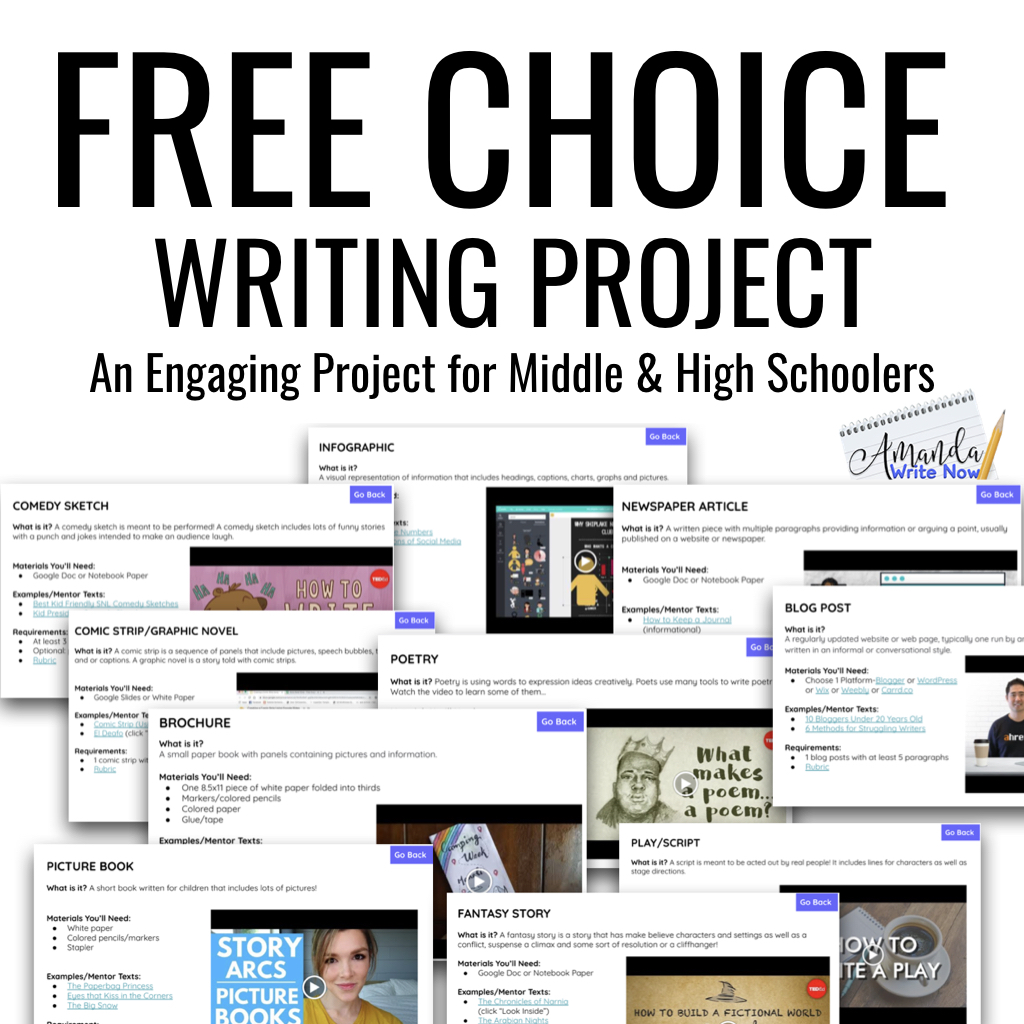
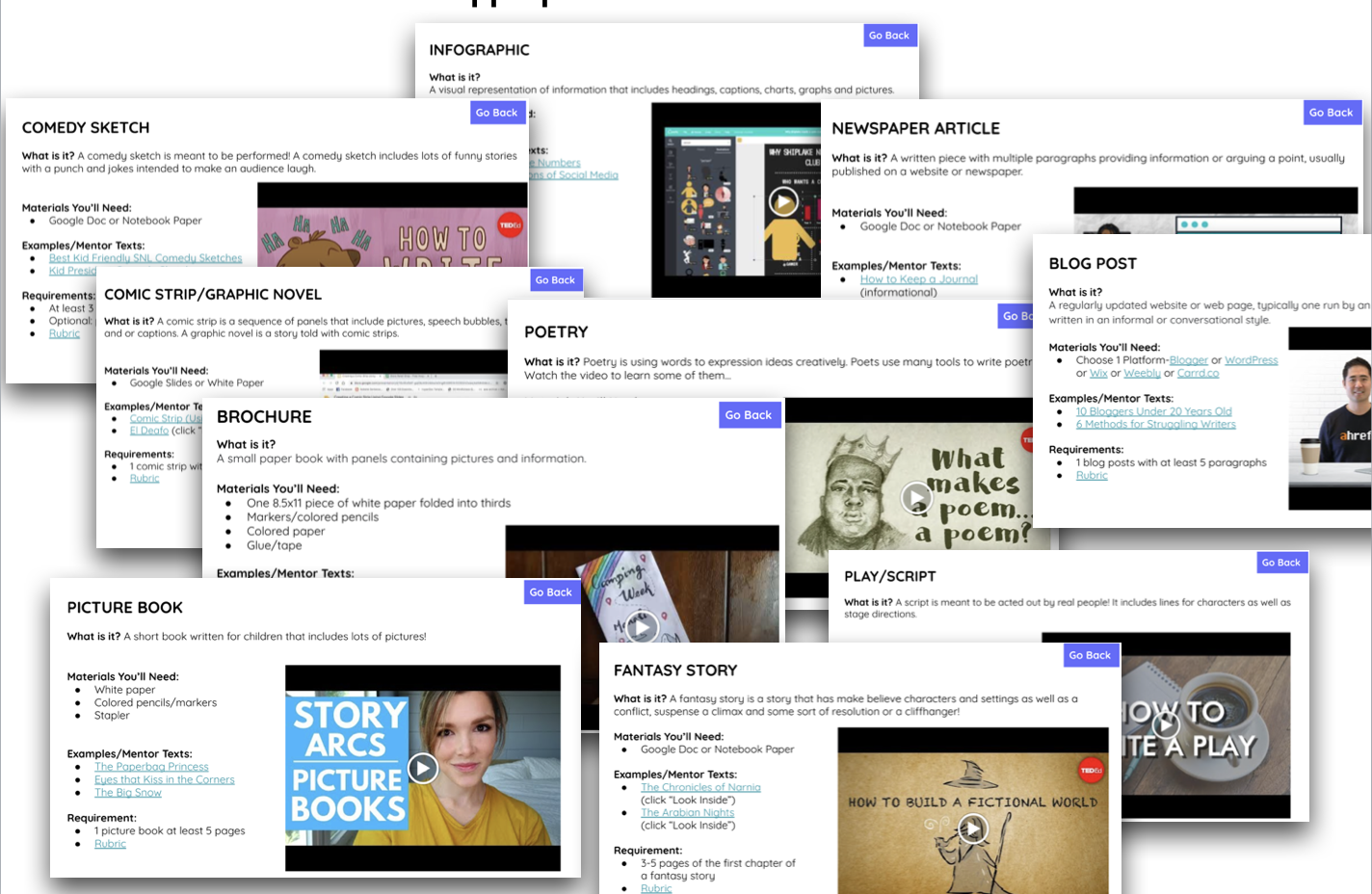
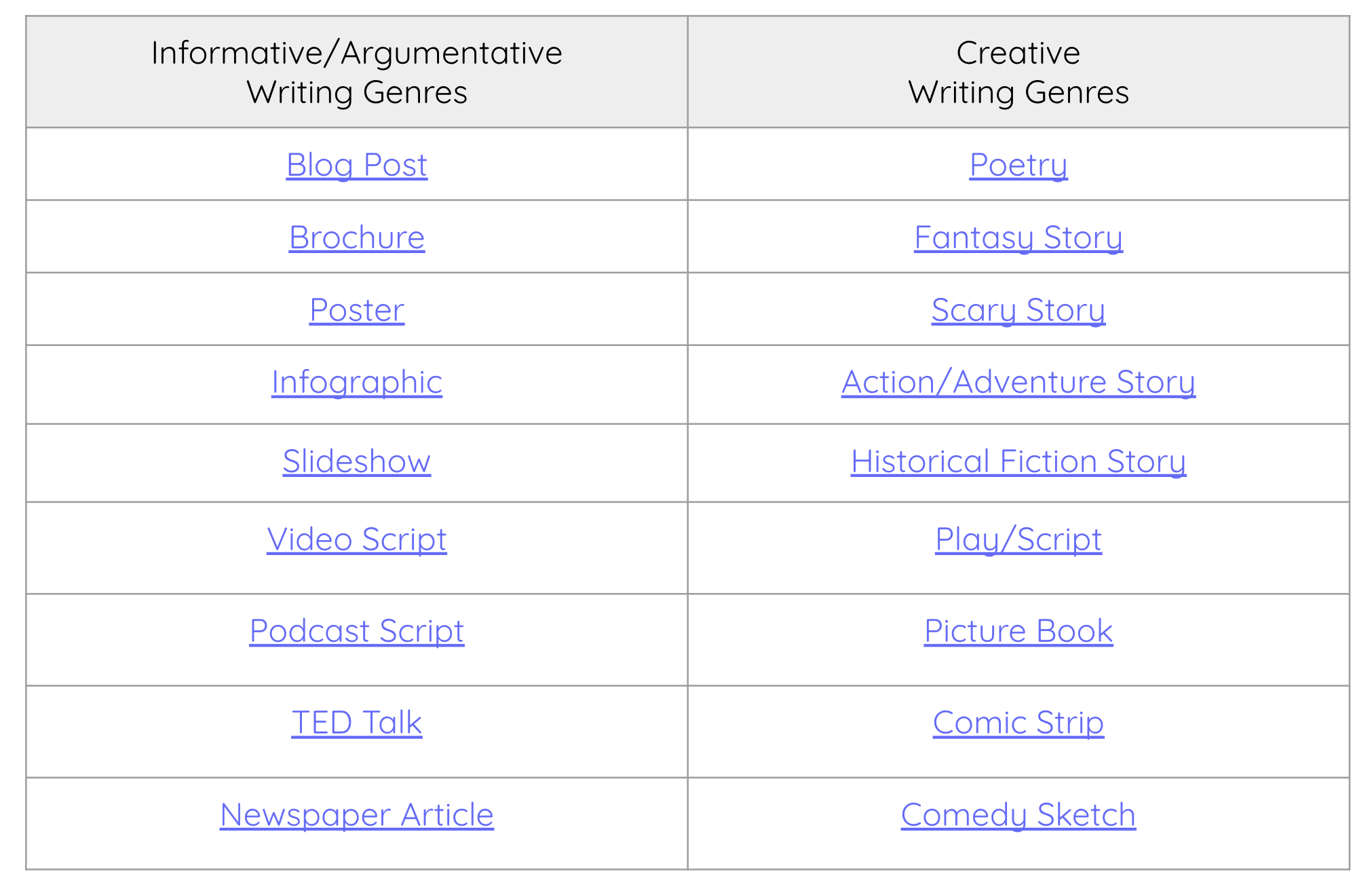


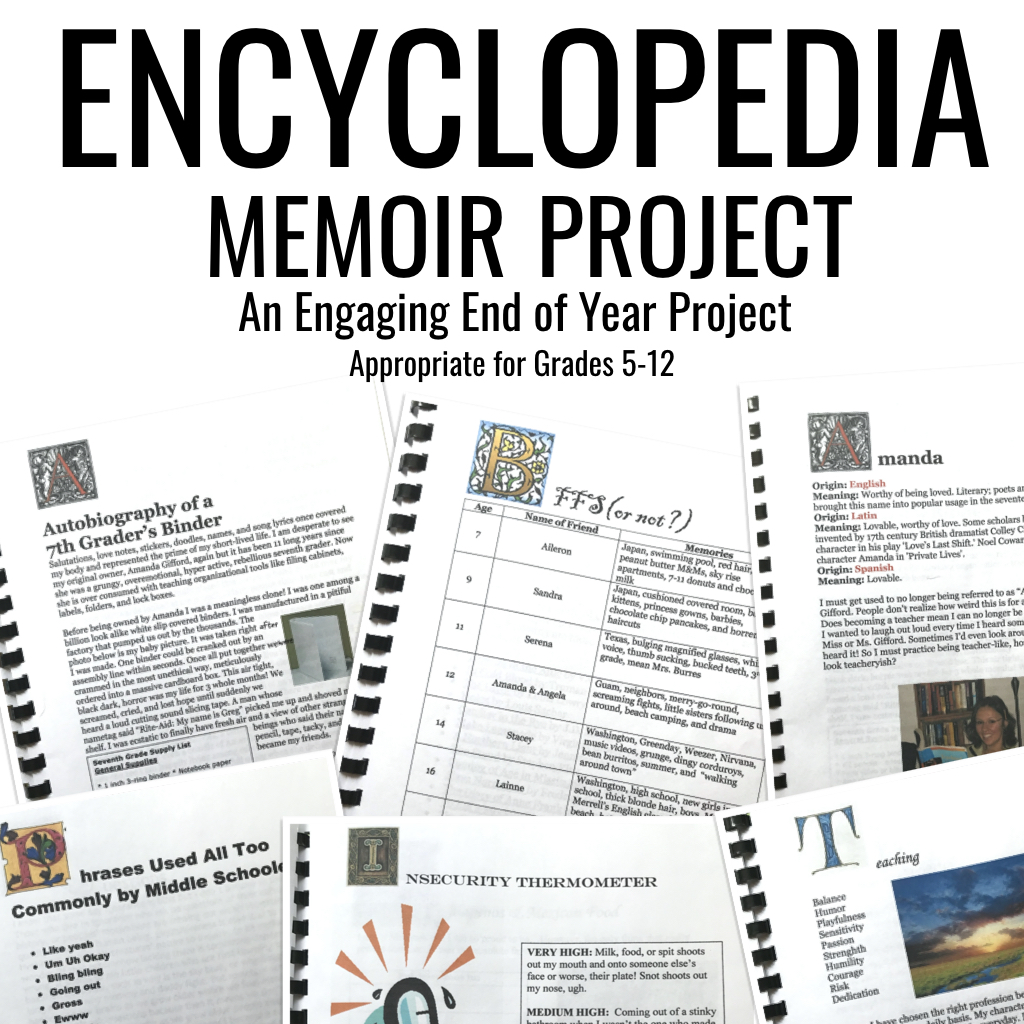

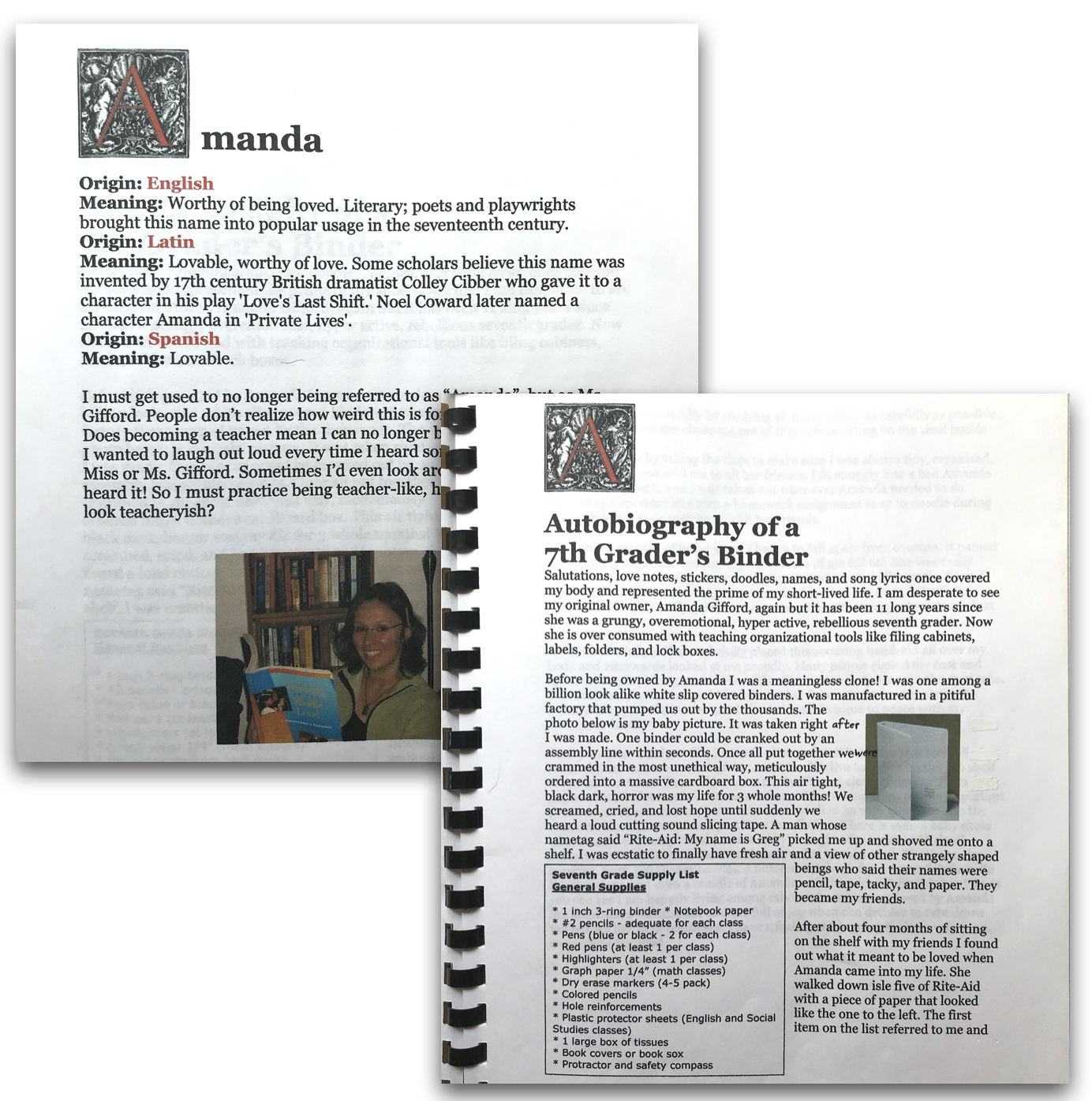
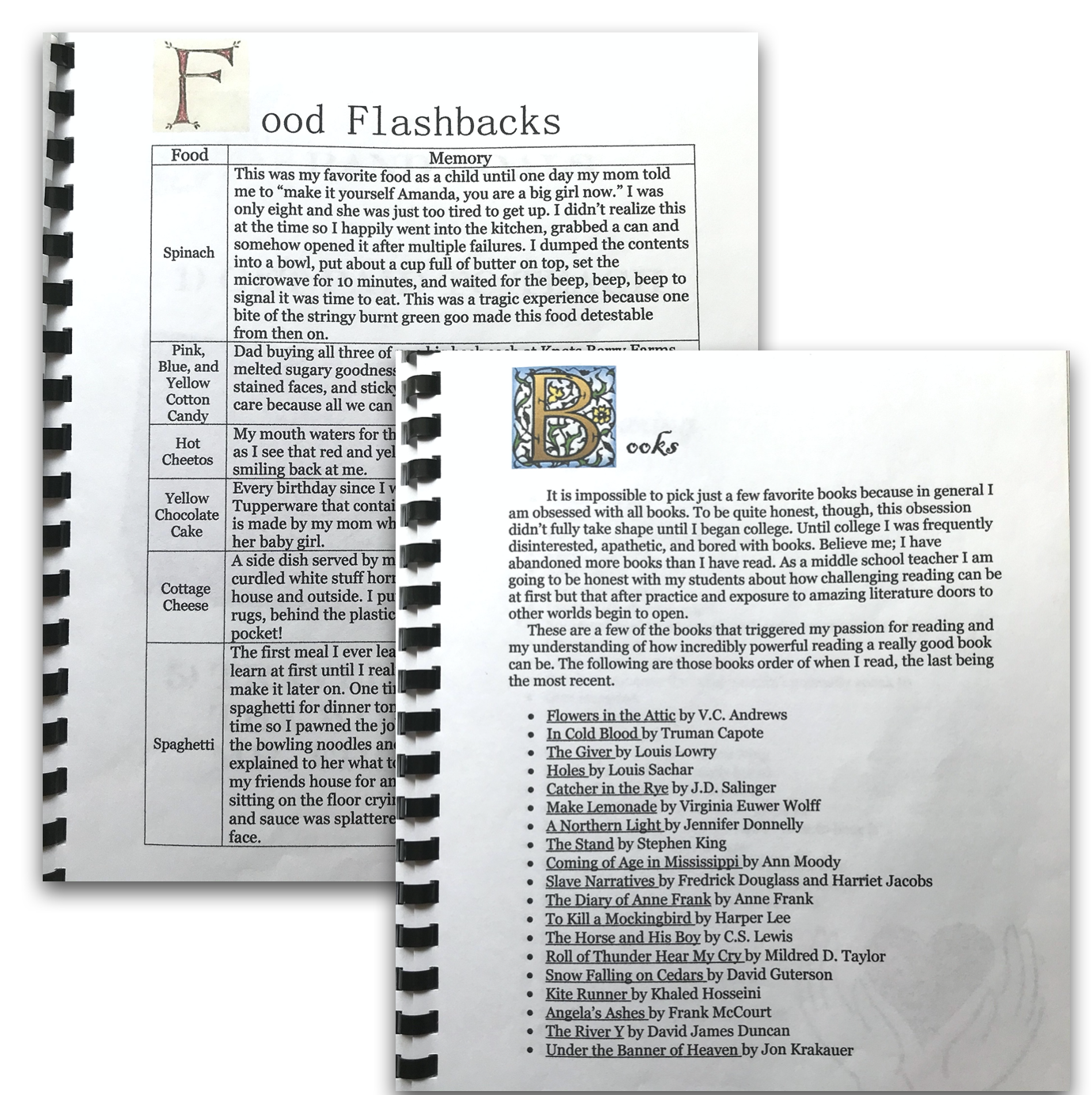
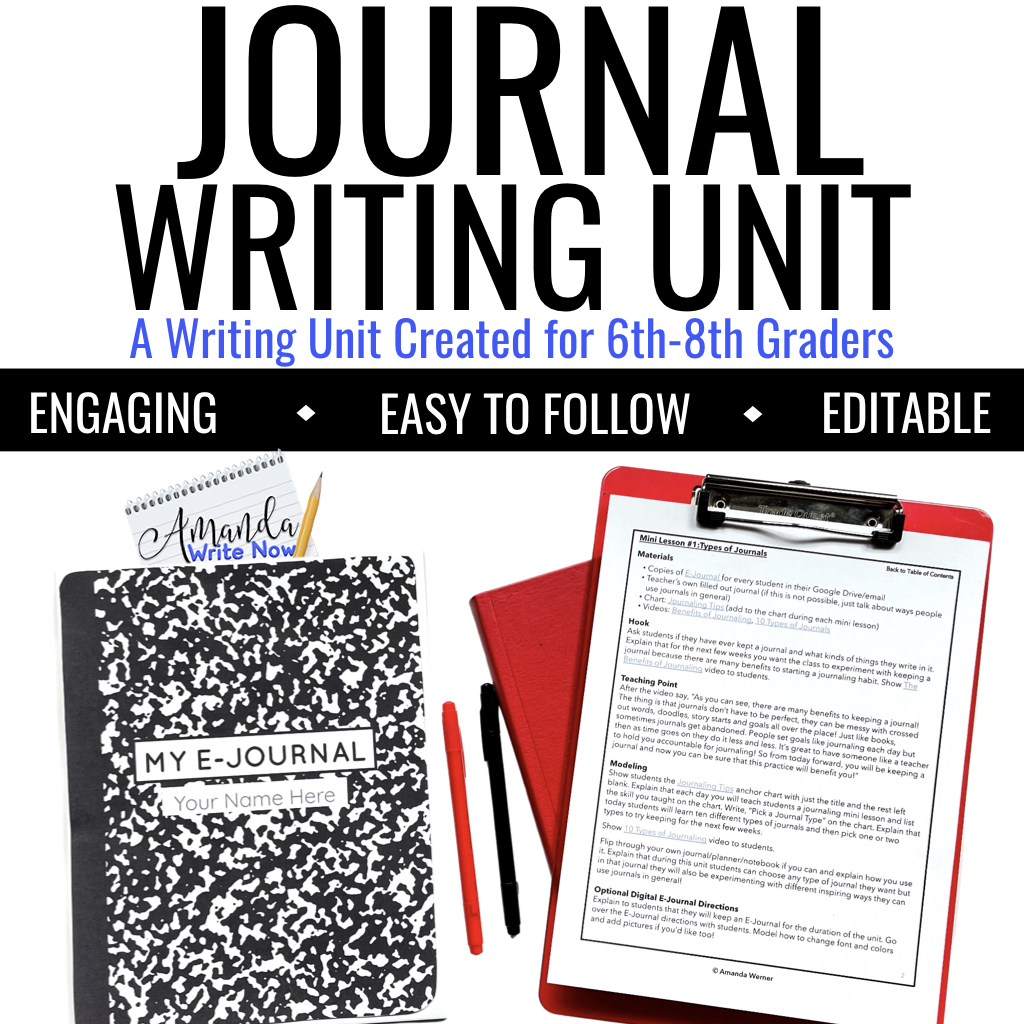
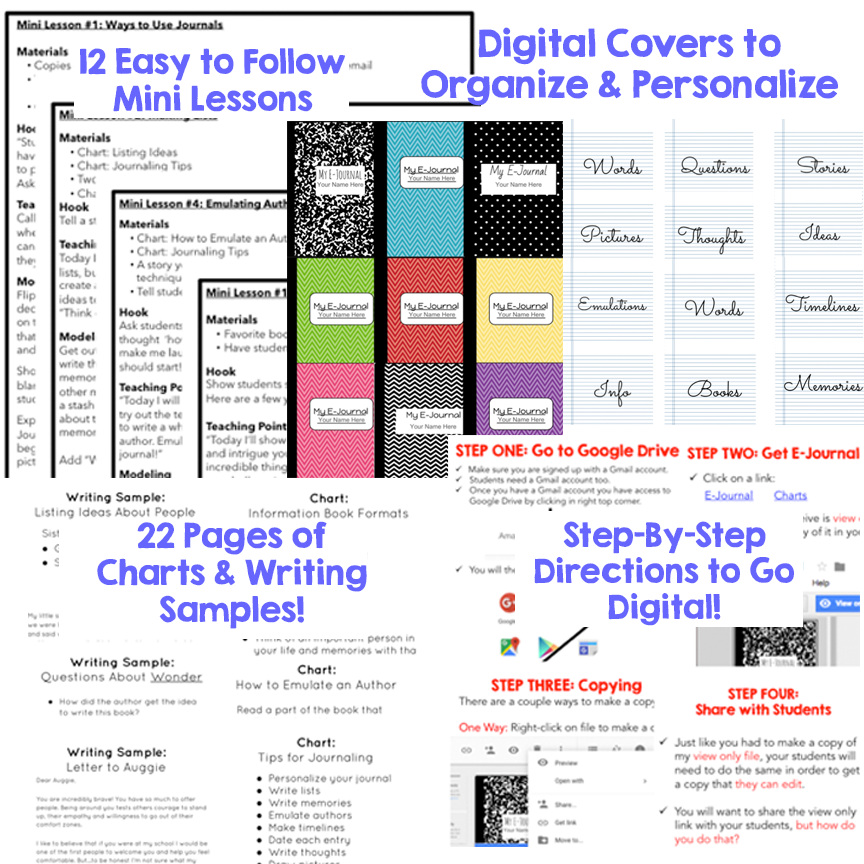



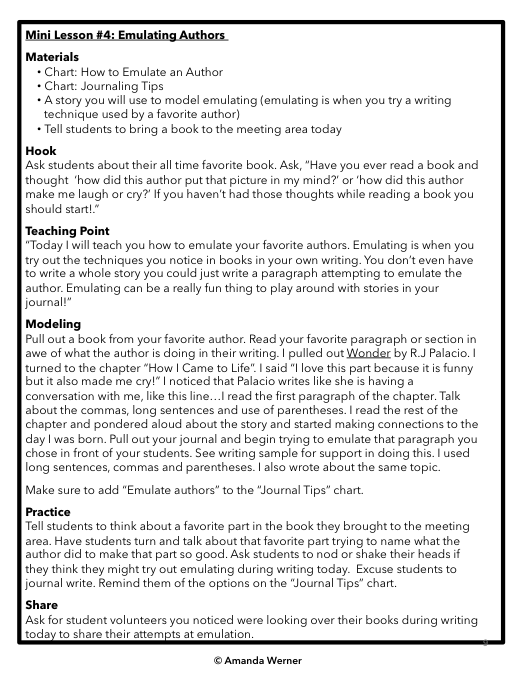



The free choice writing ideas that Amanda has developed for students at the end of the year are so inspired! I have always felt like those last couple of weeks are kind of a waste, since the kids are so burnt out (as am I), but not I feel ready to finish strong! Thanks Amanda!
I’m so happy to help Trina! Thanks for taking the time to leave a comment and let me know how these resources have helped you. I appreciate it.